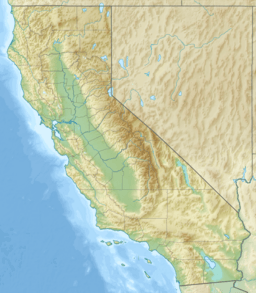Big Cave facts for kids
Quick facts for kids Big Cave |
|
|---|---|
| Highest point | |
| Elevation | 4,130 or 4,131 ft (1,259 or 1,259 m) |
| Geography | |
| Location | Shasta County, California, United States |
| Parent range | Cascade Range |
| Geology | |
| Age of rock | Pleistocene or Holocene |
| Mountain type | Shield volcano |
| Volcanic arc | Cascade Volcanic Arc |
| Last eruption | unknown |
Big Cave is a small shield volcano located in northern California. It is part of the Cascade Volcanic Arc in the Pacific Northwest. This area has many volcanoes.
Big Cave stands at about 4,130 feet (1,260 m) or 4,131 feet (1,259 m) high. It formed because huge pieces of the Earth's crust, called tectonic plates, are slowly moving. Some plates are sliding under the North American Plate. This movement happens at about 4 centimetres (1.6 in) each year.
The volcano is made of a type of rock called basalt. This gives it a rough surface. Over time, lava flows have covered much of the area around Big Cave. It sits between Big Lake to the north and Bald Mountain to the south. Big Cave is one of many volcanoes that stretch north from the Lassen Peak volcano. Scientists are not sure exactly when Big Cave last erupted. It was either during the late Pleistocene or Holocene epoch, which were very long ago. Big Cave does not have many large features. It only has some small pyroclastic cones on its northern side and at its top. These are like small hills made of volcanic rock.
Where is Big Cave?
Big Cave is found in Shasta County, California. It is located south of a place called Big Lake. To its north is Bald Mountain.
Scientists have slightly different measurements for its height. Some say it is 4,130 feet (1,260 m) tall. Others list its elevation as 4,131 feet (1,259 m).
How Big Cave Formed
The Cascade Range has been volcanically active for about 36 million years. This activity is mainly due to the Juan de Fuca tectonic plate pushing under the North American Plate. This slow movement continues today.
Volcanoes in the Cascades have erupted on and off for millions of years. The most recent period of activity started about 5 million years ago. The Cascade Volcanic Arc stretches from British Columbia in Canada all the way to the Lassen Peak area in northern California.
Big Cave is at the northern end of a group of younger volcanoes. These volcanoes stretch north from Lassen Peak. Big Cave is a shield volcano, which means it has a wide, gently sloping shape, like a warrior's shield.
Scientists believe Big Cave likely formed during the Holocene epoch. However, the United States Geological Survey is not entirely sure. It might also be from the late Pleistocene epoch. One scientist, M. A. Clynne, thought it could be about 38,000 years old.
The volcano is made of basaltic lava. It has small pyroclastic cones at its top and on its northern side. Big Cave has a low profile, meaning it doesn't stand out much. It is surrounded by a large field of hardened lava. The surface of the volcano is rough. It doesn't have any other major features.


